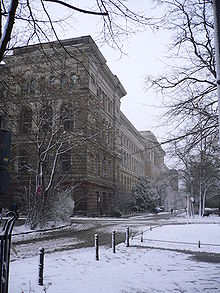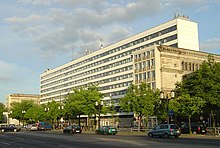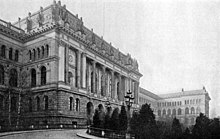Technische Universität Berlin
Technische Universität Berlin | |
| File:Technische Universität Berlin logo rot.jpg | |
| Type | Public University |
|---|---|
| Established | 1770/1799/1879 1946 |
| Endowment | State: EUR 267,2 Mio. (2007) External: EUR 78,0 Mio (2006) |
| President | Prof. Dr. Kurt Kutzler |
| Students | 26,812 (SS 2007) |
| Location | , 52°30′43″N 13°19′35″E / 52.51194°N 13.32639°E |
| Website | www.tu-berlin.de |


The Technical University of Berlin (Berlin Institute of Technology, TUB, TU Berlin, German: Technische Universität Berlin) is located in Berlin, Germany. It was founded in 1879 and, with nearly 30,000 students, is one of the largest technical universities in Germany. It also has the highest proportion of foreign students out of universities in Germany, with 20.9% in the summer semester of 2007, roughly 5,598 students. The university alumni and professor list include eight Nobel Prize winners.
History

The institution was unified in 1879 under the name Royal Technical College of Charlottenburg (later Berlin) by merging the Building Academy (Bauakademie), established in 1799, and the Vocational Academy, established in 1829. Since 1916 it has been integrated with the former Mining Academy, which was the oldest institution, founded in 1770. The college was closed after World War II on April 20, 1945 and the university re-opened on April 9, 1946 under its current name.
Campus

The TU Berlin covers ca. 600,000 m², distributed over various locations in western Berlin. The main campus is located in the borough of Charlottenburg. The seven schools of the university have some 28,200 students enrolled in more than 50 subjects (January, 2009).[1]
Organization
Since April 4, 2005, the TU Berlin has consisted of the following schools:
- Humanities
- Mathematics and Natural Sciences
- Process Sciences and Engineering
- Electrical Engineering and Computer Science
- Mechanical Engineering and Transport Systems
- Planning - Building - Environment (merge of former schools of "Civil Engineering and Applied Geosciences" and "Architecture - Environment - Society")
- Merge with school 6 (see above)
- Economics and Management
Faculty and staff
6,721 people work at the university: 319 professors, 1,832 postgraduate researchers, and 2,089 personnel work in administration, the workshops, and the central facilities. In addition there are 1,803 student assistants and 161 trainees (January 2006).
International student mobility is applicable through ERASMUS programme or through Top Industrial Managers for Europe (TIME) network.
Library
The new common main library of the Technical University of Berlin and of the Berlin University of the Arts was opened in 2004. The library building was sponsored by Volkswagen and is named Volkswagen Library. All former 17 libraries of the Technical University of Berlin and of the nearby University of the Arts were merged into the new library, but several departments still retain libraries of their own. In particular, the school of 'Economics and Management' maintains a library with 340,000 volumes in the university's main building.
Notable alumni and professors
(Including those of the Academies mentioned under History)
- August Borsig, businessman
- Carl Bosch (1874–1940), chemist, Nobel prize winner 1931
- Wernher von Braun (1912–1976), head of Nazi Germany's V-2 rocket program, saved from prosecution at the Nuremberg Trials by Operation Paperclip, first director of the United States National Aeronautics and Space Administration's Marshall Space Flight Center, called the father of the U.S. space program
- Franz Breisig (1868–1934), mathematician, inventor of the calibration wire and father of the term quadripole network in electrical engineering
- Wilhelm Cauer (1900-1945), mathematician, essential contributions to the filter design of electronic filters
- Carl Dahlhaus (1928-1989), musicologist
- Dennis Gabor (1900–1971), physicist (holography), Nobel prize winner 1971
- Fritz Haber (1868–1934), chemist, Nobel prize winner 1918
- Gustav Ludwig Hertz (1887–1975), physicist, Nobel prize winner 1925
- George de Hevesy (1885–1966), chemist, Nobel prize winner 1943
- Karl Küpfmüller (1897–1977), electrical engineer, essential contributions to system theory
- Wassili Luckhardt (1889–1972), architect
- Alexander Meissner (1883–1958), electrical engineer
- Erwin Wilhelm Müller (1911–1977), physicist (field emission microscope, field ion microscope, atom probe)
- Jakob Karol Parnas (1884–1949), biochemist, Embden-Meyerhof-Parnas pathway
- Wolfgang Paul (1913–1993), physicist, Nobel prize winner 1989
- Ernst Ruska (1906–1988), physicist (electron microscope), Nobel prize winner 1986
- Karl Friedrich Schinkel (1781-1841), architect (at the predecessor Berlin Building Academy)
- Georg Schlesinger (1874–1949)
- Albert Speer (1905–1981), architect, politician, Minister for Armaments during the Third Reich, war criminal
- Kurt Tank (1893–1983), head of design department of Focke-Wulf, designed the FW-190
- Wilhelm Heinrich Westphal (1882–1978), physicist
- Hermann W. Vogel (1834–1898) photo-chemist
- Eugene Wigner (1902–1995),physicist, discovered the Wigner-Ville-distribution, Nobel prize winner 1963
- Konrad Zuse (1910–1995), computer pioneer
References
See also
Other Universities of Berlin:
- Berlin School of Economics and Law
- Freie Universität Berlin (Free University of Berlin)
- Hertie School of Governance
- Humboldt Universität zu Berlin (Humboldt University of Berlin)
- Universität der Künste (Berlin University of the Arts)
